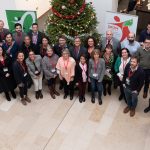
GROW Colombia: recovering the Andean Bear
Famous for the much-loved children’s character ‘Paddington Bear’, the spectacled bear, also known as the Andean bear, is South America’s only bear species and one of the most iconic mammals of the Tropical Andes.
As part of our £6.5million genomics project GROW Colombia, working with the Natural History Museum in London and the Humboldt Institute in Colombia, we will contribute to the conservation of this vulnerable species by identifying the factors involved in its population decline – helping to promote the country’s breathtaking biodiversity while making a positive economic and social impact on local communities.
We speak to the Post-Doctoral Scientist Adam Ciezarek, working closely with Dr Wilfried Haerty and Professor Federica Di Palma, about the research project.
Hi, Adam! Why did you choose to work on the Andean bear?
Andean bear populations have declined significantly. They are increasingly threatened by habitat loss and degradation as well as poaching. The development of cattle breeding encroaching on the bear’s natural habitat has led to growing conflict with humans as they have been blamed for killing livestock.
Despite the iconic status of the Andean bear and its pressing conservation issues, very little is known of their population structure. Eight core conservation areas for the bear have been established across Colombia, but we currently do not know the genetic diversity of the Andean bear populations within their habitat.
We need to use our genetic understanding of these populations to help develop and implement conservation strategies.
“Despite the iconic status of the Andean bear and its pressing conservation issues, very little is known of their population structure.”
Why is it an important species for Colombia?
The Andean bear is called the guardian of los Andes and represents the ecosystem integrity of the Andean mountain and Paramos ecosystems (High mountain ecosystems).
As Colombia looks to continue expanding its tourism industry, the Andean bear and the beautiful mountainous habitats they occupy will potentially be very valuable for ecotourism.
The Andean Bear lives in the high mountainous habitat of the Paramos mountains in Colombia.

How will you conduct the research and collaborate with the Colombian scientific community?
All steps of the research will be in close collaboration with the Colombian scientific community. We are working closely with the Alexander von Humboldt Biological Resources Research Institute (Instituto de Investigación de Recursos Biológicos Alexander von Humboldt) in particular, from collecting samples of DNA from hair and faeces, to genome assembly and population analyses.
We will also be running workshops in Colombia to further train the scientists in genome assembly, population genomics and working with museum samples.
Can you explain how the ancient DNA element of the research will work?
Andean bear skulls have been kept in museum collections both in Colombia and around the world. Some are up to 200 years old and may be from a time when bear populations were healthier. With the expertise of the Natural History Museum in London, we can extract and sequence DNA from these skulls.
This will allow us to get an insight into how levels of genetic diversity and inbreeding may have changed over a recent timescale. We can then determine to what extent recent human activity has impacted the Andean bear population structure and its genomic viability, which will be important in assessing the potential for population recovery.
“We can determine to what extent human activity has impacted the Andean bear population structure … which is important in assessing its recovery.”
What will the genome assembly reference be used for?
The genome reference assembly will be the backbone of all our work. Sequence data from living bear samples as well as ancient DNA from museum bear samples will be mapped against this and used to assess genetic diversity and population structure.
A high-quality genome assembly reference will make these population analyses much more powerful and accurate. We also anticipate that this resource will be used more broadly in evolutionary studies such as the Vertebrates Genome Project, helping us to understand vertebrate evolution.
“The Andean bear would therefore act as an ‘umbrella species’, meaning its conservation would indirectly protect other species occupying these vulnerable areas.”
How will it help other endangered or vulnerable species in Colombia?
The Andean bear is endemic to high-altitude environments in the Andes. Successful conservation would require preservation of a large amount of good quality habitat in these areas.
The Andean bear would therefore act as an ‘umbrella species’, meaning its conservation would indirectly protect other species occupying these vulnerable areas. The methods we develop will also be applicable to other endangered and vulnerable species.
Adam is hopeful that in the future the project will extend this approach to help conserve other threatened species, such as the Amazonian manatee.

Could you explain what ‘conservation corridors’ are and how they are applied to the research?
Conservation corridors are areas of suitable habitat connecting different populations, which have been separated by human activity. These are vital for preventing reproductive isolation and maintaining genetic diversity in each population.By examining modern and historical gene flow between populations, we aim to identify important conservation corridors for the bears and use this data to inform conservation strategies.
How will this research benefit the UK?
A key goal of this research is to develop capacity in the UK as well as in Colombia. Our Colombian partners have skills and knowledge that we do not have, so building collaborations will help the UK science community.
The tools and methods we develop will also help similar studies with our own endangered species. The project is also training a new generation of scientists like me to be able to cross disciplines and contribute to sustainable development goals.
“A key goal of this research is to develop capacity in the UK as well as in Colombia. Our Colombian partners have skills and knowledge that we do not have, so building collaborations will help the UK science community.”
What would you like to see next for the research?
It will be great to spread this approach out to other threatened species in Colombia, for example, the manatee and the jaguar.
Adam hopes to see the same approach extended to help the conservation of other threatened species in the Colombian Amazon including the Jaguar.





